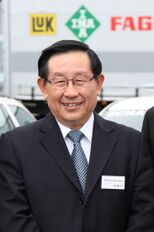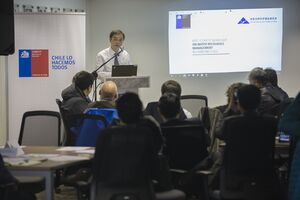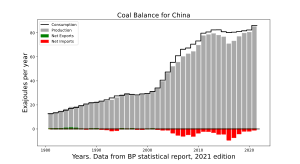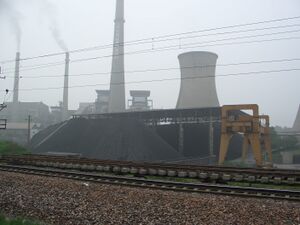وزارة العلوم والتكنولوجيا (الصين)
| 中华人民共和国科学技术部 Zhōnghuá Rénmín Gònghéguó Kēxué Jìshùbù | |
 Ministry headquarters | |
| وكالة استعراض | |
|---|---|
| تشكلت | 1958 (as Commission) 1998 (as Ministry) |
| agency السابقة |
|
| الاختصاص | Government of China |
| المقر الرئيسي | Beijing |
| الوزير المسئول |
|
| الوكالة الأم | State Council |
| الموقع الإلكتروني | www |
The Ministry of Science and Technology is the central government ministry which coordinates science and technology activities in the country. The office is located in Xicheng District, Beijing.[1]
The ministry is responsible for formulating guidelines and related policies for science and technology in China development and promoting basic and special research on science and technology.[1] The Ministry develops human resources by coordinating international scientific and technology cooperation and talent exchanges, enhancing China's innovative capabilities in worldwide scientific research.[1][2]
History of ministry
The predecessor of MOST was the National Technical Committee established at the 28th Plenary Session of the State Council in 1956. It merged with the Scientific Planning Commission to form the State Science and Technology Commission in 1958.
The commission was abolished in 1970, but was re-established in March 1978. The commission was renamed to the Ministry of Science and Technology of the People's Republic of China at the 9th National People's Congress in 1998. [1][3]
Restructuring
In 2018, the Ministry of Science and Technology was approved for restructuring at the National People's Congress in Beijing, where 15 ministries were be merged, reorganized, or abolished.[4]
The most significant departmental adjustment was the merger of the National Natural Science Foundation of China (NSFC) into the Ministry of Science and Technology. The NSFC is a semi-autonomous research funding agency that provided about $4.7 billion in funding to 120,000 research projects in 2017.[5]
In addition, the State Administration of Foreign Experts Affairs was also merged into the Ministry of Science and Technology.[5] The merger of this department reflected China's intention to invest more in global research cooperation.[6]
List of ministers

| No. | Name | Took office | Left office |
|---|---|---|---|
| Director of State Science and Technology Commission | |||
| 1 | Nie Rongzhen | 1958 | 1970 |
| post abolished | |||
| 2 | Fang Yi | March 1978 | 1985 |
| 3 | Song Jian | 1985 | March 1998 |
| Minister of Science and Technology | |||
| 4 | Zhu Lilan | March 1998 | February 2001 |
| 5 | Xu Guanhua | February 2001 | April 2007 |
| 6 | Wan Gang | April 2007 | March 2018 |
| 7 | Wang Zhigang | March 2018 | incumbent |
Cooperation
The United Nations (UN)
In December 2017, the Ministry of Science and Technology of China and the United Nations Department of Economic and Social Affairs (UN DESA) reached an agreement with the goal of strengthening knowledge sharing, capacity building and cooperation in sustainable development among countries. In addition, Mr. Liu Zhenmin, Deputy Secretary-General of the United Nations Department of Economic and Social Affairs, said that DESA and MOST signed a memorandum of understanding to encourage developing countries to conduct joint research in the field of green technology.[7]
The World Academy of Sciences (TWAS)
In July 2019, TWAS Executive Director Romain Murenzi held talks with Wang Zhigang, Minister of MOST, to discuss issues such as jointly advancing scientific development in the global South. Murenzi said that the cooperative relationship between China and TWAS began 35 years ago at the beginning of TWAS establishment, and proposed to strengthen more scientific exchanges and cooperation with the Ministry of Science and Technology of China in the future.[6]
European Union (EU)
In 2009, the Chinese Ministry of Science and Technology established a scientific cooperation program with the European Commission (CE), with the goal of conducting joint projects in scientific research areas of mutual interest. On December 16, 2015, the Ministry of Science and Technology of China launched a call for proposals. MOST will provide 200 million RMB annually to support the cooperation between China and European partners in various fields. The main supported scientific research fields are food, agriculture, biotechnology, information technology, aerospace, energy, health, etc.[8]
Australian Government
The Australia-China Science and Research Fund (ACSRF)
This fund is jointly managed by the Ministry of Science and Technology of China and the Australian government, and mainly supports strategic scientific and technological cooperation between Australia and China. The priority research fields supported by ACSRF are the fields of food and agriculture, health technology, and renewable energy. ACSRF will also fund the establishment of joint research centers, hold special scientific lectures and conduct exchange programs for young scientists.[9]
Queensland Government
The Queensland government was the first state in Australia to sign a memorandum of understanding with the Chinese Ministry of Science and Technology, originally signed in 2008 and renewed in 2014. It covers cooperation in the fields of renewable energy technology, environment, advanced materials, nanotechnology, agriculture, etc.[10]
The National Research Council Canada
In February 2016, representatives from the National Research Council of Canada and MOST signed a letter of intent to support collaboration and funding in scientific and technological innovation. Vice President of the Industrial Research Assistance Program at the National Research Council of Canada Mr. Bogdan Ciobanu said that this agreement provides channels for Canadian Small and medium-sized enterprises to cooperate, fund, and promote with their Chinese counterparts and explain that this partnership will increase the global presence of Canadian companies.[11]
Innovation Fund Denmark
In 2020, MOST and Innovation Fund Denmark carried out bilateral cooperation on sustainable city development solutions. In this project, Innovation Fund Denmark will allocate 15 million Danish krone, and MOST will allocate 20 million RMB to support four to five joint innovation research projects. The background of this cooperation is that both parties want to contribute to sustainable urban development, and the priority areas for funding are energy storage and smart city.[12]
Supported projects
Chronic kidney disease survey
The survey is a nationwide public health survey supported by the Ministry of Science and Technology of China, and a total of 50,500 adults were invited to conduct the survey. The background of this survey is that the prevalence of chronic kidney disease in developing countries is relatively high,[13] but there is no such related survey in China. To specifically analyse the factors related to chronic kidney disease, this survey uses logistic regression.
The survey concluded that the estimated prevalence of chronic kidney disease in China is similar to that in developed countries such as the United States and Norway. However, the prevalence of stage 3 and stage 4 chronic kidney disease is lower than the prevalence in the United States and Norway.
Researchers speculate that the prevalence of hypertension and diabetes in China has increased rapidly in the past 20 years. Therefore, the prevalence of stage 3 and stage 4 chronic kidney disease will gradually increase in the next decade. The final result shows that chronic kidney disease has become one of the most important public health problems in China, and it needs more attention in rural areas with the poor economy.[14]
Plasma Surface Metallurgy project
The MOST has corresponding support in material research in2018.The main research direction of this project is the plasma surface metallurgy technique. The research has developed an alloy material that can withstand the requirements of industrial applications above 800 °C and has oxidation resistance. This alloy material will contribute to China's aerospace industry and automotive industry.[15]
Coal energy development
Since 2005, the Ministry of Science and Technology of China has formulated the main development direction of China's medium and long-term national energy is the new coal chemical industry, to reduce environmental pollution and dependence on imported crude oil.[3][16]
Before 2005
Most of China's energy was produced by burning coal. This method of coal utilization would produce a lot of harmful gases, which directly led to the world's top ten polluted cities all in China, and huge economic losses. Since 2005, under the strategy of the Ministry of Science and Technology, the energy consumption and industrial scale of the coal chemical industry have increased year by year. This strategy is expected to reduce China's air pollution and efficient utilization of coal and other issues.[17]
After 2010
An article published in Renewable & sustainable energy reviews in 2015 pointed out that China's energy consumption and production in 2010 were greater than the early forecasts of the Ministry of Science and Technology of China. China's energy consumption has grown rapidly from 6% to 20% of the world's energy consumption in 30 years. In addition, carbon dioxide emissions have risen from 8 percent of the world's total to 24 percent in 30 years.[18] These facts prove that the new coal chemical industry promoted by the Ministry of Science and Technology of China in 2005 has not freed China from problems such as excessive energy consumption and air pollution. The main reason for the wrong direction of the national energy development strategy is that the Ministry of Science and Technology of China incorrectly estimated the modern per capita living energy consumption. In the context of high tech development, China's per capita living energy consumption is on average 50% higher than a decade ago. [16]
Future
It is speculated that the future energy development strategy formulated by the Ministry of Science and Technology of China will consist of three parts, namely improving energy efficiency, using more non-coal energy, and promoting national energy conservation. As for the specific energy development strategy, the Ministry of Science and Technology of China has not officially issued a statement.[16]
See also
- Hydrogen energy vision and technology roadmap
- Ministries of China
- Science and Technology Daily
- Central Science and Technology Commission
References
- ^ أ ب ت ث Ministry of Science and Technology of the People's Republic of China. March 2002. ProQuest 454710684.
- ^ "Devex News Agency".
- ^ أ ب Liu, Yuan; Xu, Xing-lian; Zhou, Guang-hong (يناير 2007). "Changes in taste compounds of duck during processing". Food Chemistry. 102 (1): 22–26. doi:10.1016/j.foodchem.2006.03.034.
- ^ Cyranoski, David (مارس 2018). "Chinese leaders create science mega-ministry". Nature. 555 (7697): 425–426. Bibcode:2018Natur.555..425C. doi:10.1038/d41586-018-03246-w. PMID 29565413. S2CID 4131231. ProQuest 2017932500.
- ^ أ ب "University World News Agency". Retrieved مارس 21, 2018.
- ^ أ ب "The World Academy of Sciences". يوليو 29, 2019. Retrieved يوليو 29, 2019.
- ^ "United Nations collaborating".
- ^ "New Opportunities for EU-China Collaboration". مارس 22, 2016.
- ^ "AU and CN Collaboration". نوفمبر 18, 2021.
- ^ "Queesland and China Collaboration". ديسمبر 6, 2016.
- ^ "Canada and China Collaboration". Retrieved فبراير 16, 2016.
- ^ "Denmark and China Collaboration".
- ^ Ivanovski, Ninoslav (2012). "Chronic kidney disease in the developing countries! Are we really so different?". Annals of African Medicine. 11 (2): 121. PMID 22500358. قالب:Gale ProQuest 940871254.
- ^ Zhang, Luxia; Wang, Fang; Wang, Li; Wang, Wenke; Liu, Bicheng; Liu, Jian; Chen, Menghua; He, Qiang; Liao, Yunhua; Yu, Xueqing; Chen, Nan; Zhang, Jian-e; Hu, Zhao; Liu, Fuyou; Hong, Daqing; Ma, Lijie; Liu, Hong; Zhou, Xiaoling; Chen, Jianghua; Pan, Ling; Chen, Wei; Wang, Weiming; Li, Xiaomei; Wang, Haiyan (2012). "Prevalence of chronic kidney disease in China: A cross-sectional survey". The Lancet. 379 (9818): 815–822. doi:10.1016/S0140-6736(12)60033-6. PMID 22386035. S2CID 43174392.
- ^ Zhou, Bing; Wang, Ya-Rong; Zheng, Ke; Ma, Yong; Wang, Yong-Sheng; Yu, Sheng-Wang; Wu, Yu-Cheng (ديسمبر 2020). "Anti-oxidation characteristics of Cr-coating on surface of Ti-45Al-8.5Nb alloy by plasma surface metallurgy technique". Chinese Physics B. 29 (12): 126101. doi:10.1088/1674-1056/aba9c2. S2CID 225418174.
- ^ أ ب ت Xie, Kechang; Li, Wenying; Zhao, Wei (نوفمبر 2010). "Coal chemical industry and its sustainable development in China". Energy. 35 (11): 4349–4355. doi:10.1016/j.energy.2009.05.029.
- ^ Teng, Xiangyu; Liu, Fan‐peng; Chiu, Yung‐ho (نوفمبر 2020). "The impact of coal and non‐coal consumption on China's energy performance improvement". Natural Resources Forum. 44 (4): 334–352. doi:10.1111/1477-8947.12207. S2CID 225378368.
- ^ Fan, Jie; Wang, Qiang; Sun, Wei (سبتمبر 2015). "The failure of China׳s Energy Development Strategy 2050 and its impact on carbon emissions". Renewable and Sustainable Energy Reviews. 49: 1160–1170. doi:10.1016/j.rser.2015.04.096. S2CID 154572564.
External links
- Short description matches Wikidata
- Use American English from February 2019
- All Wikipedia articles written in American English
- Use mdy dates from February 2019
- Articles containing صينية-language text
- Official website different in Wikidata and Wikipedia
- Government ministries of the People's Republic of China
- Science and technology in the People's Republic of China
- Science and technology ministries
- Ministries established in 1998
- 1998 establishments in China



